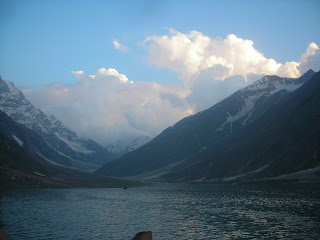Lake Saif-ul-Muluk is undoubtedly one of the most scenic lakes of the World. Located at about 30 minute distance from Naran in Kaghan Valley, it is a crystal clear bowl of green water at a height of approximately 10,578 Feet above mean sea level.
It is strikingly beautiful and captures the eyes of the tourists. The effect seems to be magical in every sense of the word.
After crossing (or in literary terms - Climbing, because the bazaar is all up-hill) Naran Bazaar, you will find a bridge over a narrow stream of water. This water in coming from Lake Saif-ul-Muluk, and the track moving along the stream will guide you to the lake itself.
Although you can reach Naran on your personal car, but trip from naran to Lake Saif-ul-Muluk must not be attempted on it. It is highly recommended that a 4x4 Jeep should hired from Naran till the lake, which is hardly a 35-45 minute journey. The track is small and bumpy and a trained driver will take you up without much hassle. You can hire a jeep from Naran Bazaar or the bridge at the end of the bazaar.
A sunset at Lake Saif-ul-Muluk is an unforgettable experience and if you are fond of camping, then Lake Saif-ul-Muluk is one place you will never like to miss. The only guest room available on the lake-side belongs to the Forest Department of Khyber Pakhtunkhawa Province and you can get it booked from their office in Peshawar, if you are so keen at spending a night there.
There are many famous stories about Lake Saif-ul-Muluk and one of them narrates that fairies come to take bath in this lake during the full-moon nights. I can not comment on the authenticity of these stories, but you will have to spend a night there to find out for yourself - How true are these stories?
Lake Saif-ul-Muluk is an unmissable tourist attraction in Kaghan Valley and any tourist travelling in the valley can not even think of missing it.
I have the honor of watching this lake in different times of the year, starting from March to December and the lake has different colors in every month, yet every color is more beautiful than the others. I have seen it frozen in early March as well.
Have you visited Lake Saif-ul-Muluk and how did you find it? Feel free to share your experience below in Comments Section!
It is strikingly beautiful and captures the eyes of the tourists. The effect seems to be magical in every sense of the word.
How to get to Lake Saif-ul-Muluk?
From Balakot, you have to travel North towards the small town of Naran, which in fact is one of the largest towns in Kaghan Valley and the main tourist stop during your trip to Kaghan Valley. Naran is about 90 kms from Balakot or 2.5 hours of drive on car.After crossing (or in literary terms - Climbing, because the bazaar is all up-hill) Naran Bazaar, you will find a bridge over a narrow stream of water. This water in coming from Lake Saif-ul-Muluk, and the track moving along the stream will guide you to the lake itself.
Although you can reach Naran on your personal car, but trip from naran to Lake Saif-ul-Muluk must not be attempted on it. It is highly recommended that a 4x4 Jeep should hired from Naran till the lake, which is hardly a 35-45 minute journey. The track is small and bumpy and a trained driver will take you up without much hassle. You can hire a jeep from Naran Bazaar or the bridge at the end of the bazaar.
A sunset at Lake Saif-ul-Muluk is an unforgettable experience and if you are fond of camping, then Lake Saif-ul-Muluk is one place you will never like to miss. The only guest room available on the lake-side belongs to the Forest Department of Khyber Pakhtunkhawa Province and you can get it booked from their office in Peshawar, if you are so keen at spending a night there.
There are many famous stories about Lake Saif-ul-Muluk and one of them narrates that fairies come to take bath in this lake during the full-moon nights. I can not comment on the authenticity of these stories, but you will have to spend a night there to find out for yourself - How true are these stories?
Lake Saif-ul-Muluk is an unmissable tourist attraction in Kaghan Valley and any tourist travelling in the valley can not even think of missing it.
I have the honor of watching this lake in different times of the year, starting from March to December and the lake has different colors in every month, yet every color is more beautiful than the others. I have seen it frozen in early March as well.
Have you visited Lake Saif-ul-Muluk and how did you find it? Feel free to share your experience below in Comments Section!












